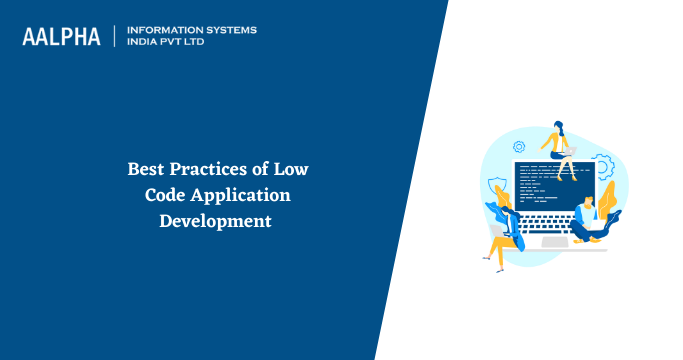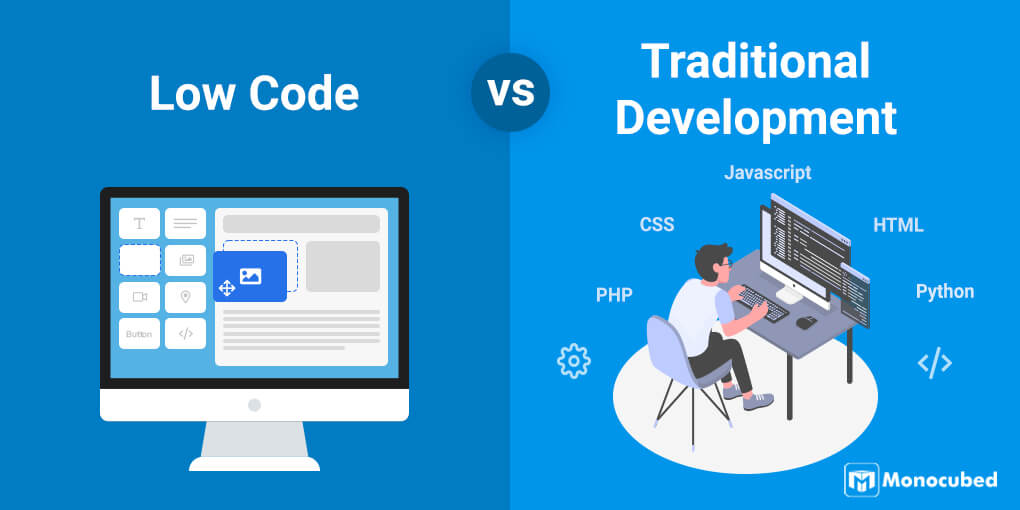Free Reasons On Picking Legacy application modernization with Low-code
Free Reasons On Picking Legacy application modernization with Low-code
Blog Article
Advantages Of Low Code Application Development For Non-Developers
Because of a variety of reasons due to a variety of factors, low-code development is more accessible for non-developers. They are commonly referred to as "citizens developers."
Drag-and-Drop Builders: Low-code systems provide drag-and-drop interfaces that allow people who are not developers, and without the need to write code, to create visual applications. This makes it easier for those with less technical backgrounds to get involved in the process of development.
WYSIWYG editors The WYSIWYG editors "What You See Is What You get" editors allow users to design interfaces and workflows that are similar to the finished product. This makes it much easier to learn and use.
Simplified Design of Workflow Logic and Workflow:
Visual Workflow Modeling: Users can use visual workflow to develop business processes, applications logic and flowcharts by using diagrams as well as visually-designed flowcharts. These methods are more intuitive than conventional coding techniques.
Pre-built Logic Components Low-code platforms contain logic components that are already built (e.g. conditional statements and loops) that can be easily configured which eliminates the need for complicated coding.
Templates and components that can be reused:
Library of Pre-built Templats A lot of Low-Code platforms provide templates that are based off of common application types. Non-developers will be able to customize these templates if needed.
Reusable modules and widgets: The development of a website is simplified by using reusable components as well as modules. This reduces the requirement for technical expertise.
Guided Development and Tutorials
Step-by -Step Instructions: Platforms usually provide tutorials that are on screen, guided development pathways, as well as other tools to assist people who are not developers to create applications.
Interactive Tutorials: Interactive and hands-on tutorials enable users to learn by doing. They gain confidence by using the platform.
Integration with Tools Already in Use
Seamless Integration: Low-code platform are designed to be integrated seamlessly with the existing systems, tools, and software (e.g., ERP or CRM, ERP). This enables non-programmers who do not have a prior experience in programming to design applications that can work with their current workflows.
APIs and Connectors: APIs built-in and connectors simplify the integration process by allowing non-developers to connect their applications with external services, without requiring complex coding.
Collaboration Features:
Team Collaboration Real-time collaboration, shared workspaces and shared workspaces permit non-developers, business analysts and other stakeholder groups to effectively collaborate with developers who are professionals.
Role-based Access Control: Developers can be assigned specific roles that have appropriate access levels, ensuring that they can participate in the process of development without having to compromise security and functionality.
Automated Testing & Debugging
Low-code platforms are often equipped with testing and debugging software that automates these processes. This makes it much easier for non developers to verify their applications work correctly.
Error Highlighting: Whenever issues arise the platform flags errors and suggests fixes, guiding non-developers through troubleshooting techniques.
The capacity of low-code software to allow development for non-developers is its biggest benefit. Low-code platforms enable business users to be involved in the creation and maintenance of applications through the use of intuitive visual tools as well as a guiding experience. This is a bridge between technical implementation and business demands. Check out the most popular click this link about Low-code Platform for application development for more info including rapid app development, application modernisation, push alerts, developing mobile apps, cloud software applications, low code platforms, azure sql databases, stored sql procedures, app platforms, push notifications and more.
Benefits Low-Code Applications In Governance And Safety
Low-code application development offers several benefits in terms of governance and security, which are essential for ensuring that the application is compliant and secure. They also ensure that they are well-managed throughout their lifespan. Here are the key benefits: Centralized Governance
Unified Management Console: Low-code applications typically provide a centralized management console, where administrators are able to oversee and manage all the applications, ensuring consistent governance across the company.
Role-Based Access Control RBAC: These platforms come with powerful role-based controls that permit administrators to set access rules. This permits only authorized users to modify or access certain areas of the program.
Conformity and Regulatory Conformity:
Built-in Compliance Features: Many low-code platforms are designed to conform to the industry norms and regulations (e.g., GDPR, HIPAA). They offer frameworks and tools to help ensure that applications meet these requirements.
Audit Trails and Logging Comprehensive logging and audit trails are usually combined, allowing businesses to track changes, monitor access, and make sure that they are in compliance with internal and external laws.
Enhanced Security Measures:
Data Encryption: Low-code platforms generally provide encryption built-in for data at rest and while in transit, making sure that sensitive information is protected.
Security Certifications - Many lowcode providers have security certificates, like ISO 27001 (or SOC2), which demonstrate the adherence to high security standards. Users can be assured that these providers adhere to the standards.
Automated security updates:
Regular Security Updates and Patches : Low-code platform handle automatic security patches, updates and updates. The applications are thus secured from threats of the present without the need for developer intervention manually.
Security Monitoring: Constant security monitoring tools can be used to send real-time notifications as well as information about potential security issues.
Data Governance
Data Access Policy: These platforms allow organizations define and enforce policies for access to data, while making sure that only authorized individuals have access to data and that it is used properly.
Data Masking and anonymization The built-in tools that hide and anonymize data helps safeguard sensitive data in testing and development environments.
Consistent Application Management
Pipelines for deployment and development Low-code platforms provide integrated pipelines for development and deployment, which include security checks. These ensure that security is maintained through the entire lifecycle of the application.
Version Control: An integrated version control facilitates the control of modifications. It also guarantees that all changes to the software are recorded, and if required reversed. This is to ensure the integrity of the software.
User Authentication Authorization
Single Sign-On: The support for SSO as well as other sophisticated authentication methods simplify the management of users and increases security.
Multi-Factor Authentication A lot of platforms have integrated multi-factor authentication, which adds additional security for accessing applications.
Policy enforcement and Compliance monitoring:
Low-code platforms have templates for policies predefined and can aid organizations in implementing security and governance guidelines.
Tools for Monitoring Compliance The tools offer regular monitoring and report about compliance levels, making it much easier to spot and fix any issues that could arise.
Integrating with Existing Security Infrastructure
Seamless integration: Low-code platforms can easily be integrated into the existing security tools and systems like firewalls and SIEM products (Security Information and Event Management), and identity management systems.
API Security: API security features to protect data and ensure application integrity are built into the API.
Training and Best Practices:
Guided Best Practices: A number of platforms offer guidelines and best practices for secure application development, helping non-developers adhere to security guidelines.
Some lowcode providers offer tools and security education for users to learn how to create and maintain secure applications.
Overall the governance and security advantages of low-code application development make sure that applications are created and maintained in a safe and compliant way. These platforms provide all the tools and frameworks required to safeguard sensitive data and enforce policies while maintaining regulatory compliance. Read the top this hyperlink for website recommendations including cross platform app development, multiplatform mobile app development, rad application development, rad development, rad application development, driver jdbc, rapid action development, rapid app development, multiplatform mobile app development, cloud software applications and more.
Community And Support From The Vendor Are Two Benefits Of Low Code Application Development.
Low-code platform development has many advantages, including vendor support and community. This is crucial for ensuring the success of application implementation as well as ongoing maintenance and constant improvement. Here are some of the main advantages.
Comprehensive Technical Support:
Dedicated Support Teams Many low-code platforms offer dedicated support teams that can help in technical problems, problem-solving and advice. This will ensure that any issues will be quickly solved.
Certain vendors provide 24/7 support. This is especially beneficial to global businesses with multiple time zones.
Training and Onboarding
Structured training programs: Vendors offer structured training courses, such as webinars and certification courses. This helps users to quickly get to grips with the platform.
Customized Onboarding A lot of vendors offer individualized services to assist their new customers get onboard efficiently and adapt it to their specific needs.
Updates and Enhancements, Regularly, and Improvements:
Continuous Improvements: Low-code companies regularly release updates with performance enhancements, new features, and security patches to ensure that the platform is up-to-date.
Feedback Integration: Vendors often integrate feedback from users into their development cycles, making sure that their platform is constantly evolving to meet the ever-changing needs of its users.
Comprehensive Documentation:
Comprehensive Documentation: A comprehensive and well-organized documents are usually available that covers everything from basics to advanced customization. This assists users in finding solutions on their own.
API References API documentation can aid developers customize and integrate applications using the Low-Code platform.
Professional Consulting Services
Expert Consulting: Many companies offer consulting services to help users with complex implementations and architecture designs, as well as strategic planning.
Custom Development Services: Certain vendors offer custom development services to create features or integrations for their customers which are not easily available.
Community Support
Active User Communities:
Forums and Discussion Panels: Many low-code platforms have vibrant online communities, where users can ask questions, discuss strategies, and even collaborate with one another on the best methods.
User Groups and Meetings: Local and virtual groups of users and meetups provide opportunities to learn, network, and share experiences with others.
Collaboration and knowledge sharing:
Community-Contributed Resources: Users often share templates, modules, and extensions that they have developed, which can be reused or adapted by others, accelerating development and innovation.
Crowdsourced Solutions: The collective experience and experience of a group can be a valuable tool for troubleshooting and finding creative solutions.
Learning and Development
Community-led training: Many communities offer workshops, webinars and training sessions facilitated by knowledgeable users.
Online Tutorials: Community members create and share many online tutorials, how-tos and tutorials. These resources are made available to everyone.
Feedback and Influence
Product Feedback Channels. Forums for community members usually have channels that allow you to provide feedback to the manufacturer. The feedback you provide can affect the development and improvement of features.
Beta Testing: Members of active communities may have an opportunity to participate. This allows them to get early access and participate in the creation of the platform.
Recognition and Support
Community Recognition Programs: Many vendors provide recognition programs for active community members. Examples include MVP (Most Valuable Professionals) that recognizes contribution of community members.
Peer Support : Members of the community give support to each other by sharing their experiences and providing advice. They build a supportive and supportive culture by sharing knowledge.
In general, the combination of strong vendor support and active, engaged communities creates a broad ecosystem of support for development with low-code. Users will have the ability to gain access to the experts, resources and collaboration opportunities they require to successfully build, deploy, maintain and improve their applications.